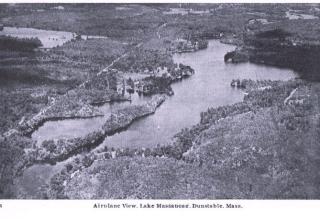The Great Gulf Disaster

The Great Gulf Disaster
Lake Massapoag was originally full of islands, more than 600 acres in size, at least 20 feet deeper than it is today. It was “teeming with salmon, shad and alewives” and small groups of Native Americans lived along the shores fishing and farming.
Today the water for the lakes comes from Cowpond Brook entering from Groton to feed Upper Lake Massapoag then flows over the upper dam at Island Pond Rd. into Middle Lake Massapoag and finally over the lower dam into Lower Lake Massapoag and ending at Rte. 113. The lower dam (down Off Pond St.) is located at what was called the “great Gulf”. The water flows on to create Black Brook and finally joins Salmon Brook behind the Dunstable Library.
Samuel Adams (but not the Adams of Revolutionary War fame) saw the potential for Dunstable’s first water- powered grist mill located at the end of Lake Massapoag closest to Off Pond St. The chosen area was called the Great Gulf and was considered to be one of “the most beautiful, wild and romantic places in the entire town”.
It was said that in the early 1700’s, Mr. Adams went to sell his flour and left the mill in the hands of a disgruntled servant who felt that his master treated and feed him poorly (cold bean-porridge) and thus bore Mr. Adams ill will. During the miller’s absence, a huge rainstorm caused the lake level to rise so much that it created a small opening in the sand of the embankment by the mill sluice way. Instead of plugging the hole, the workman watched it get larger and larger until finally it washed away major portions of the huge natural dam and carried the mill, out buildings and storehouse with it to flood the valley below. The water level was said to drop 20 plus feet, creating Lower Lake Massapoag, and Black Brook, changing Sewall’s Brook from an outlet to an inlet and leaving a tremendous number of fish dying on mud banks.
No record shows what happened to the worker but, in 1775, a second grist mill was constructed and operated at what was left of the Gulf by Mr. Jonathan Woodward, Sr. (Mr. Woodward reached the remarkable age of one hundred-one years, seven months, and thirteen days) was assisted in his labors by his wife Sarah Read. She was said to have weighed 400 pounds and could easily remove bags of grain from the back of a horse and carry them to the grinding-hopper in the mill.
It is remarkable how just one spiteful action completely changed the geography of our community and the citizens who lived and worked here.

